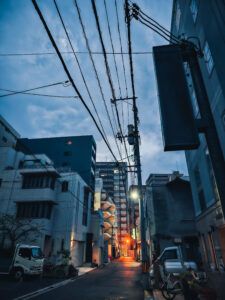The Yamanote Line, a mesmerizing green ring that encircles the heart of Tokyo, is more than just a public transit system; it’s a vibrant thread woven into the fabric of the city. Serving as a lifeline for millions of commuters and tourists alike, this circular railway connects 29 stations, each with its unique charm and character. As travelers embark on a journey along the Yamanote Line, they traverse not only the bustling metropolis but also a rich tapestry of history, culture, and community. In this article, we explore various facets of the Yamanote Line, from its historical roots to its contemporary significance, inviting you to experience Tokyo through this iconic transit route.
The Yamanote Line: Tokyo’s Circular Lifeline Explored
The Yamanote Line is often described as the heartbeat of Tokyo, encircling the city and providing a reliable means of transportation for millions. Stretching over 34 kilometers, it connects a plethora of neighborhoods, each pulsating with its unique rhythm. The line operates as a loop, making it convenient for passengers to hop on and off at various stations, allowing them to explore different facets of Tokyo life. The trains run frequently, with intervals as short as two to three minutes during peak hours, making it one of the busiest railway lines in the world.
The circular nature of the Yamanote Line symbolizes connection and continuity in a city known for its rapid pace of life. Each station serves not only as a transit point but also as a gateway to the diverse cultural, social, and economic landscapes that populate Tokyo. From the bustling streets of Shibuya to the quiet elegance of Meiji-Jingumae, the Yamanote Line provides a front-row seat to the contrasts and harmonies that define this vast metropolis.
While the Yamanote Line is primarily a commuter railway, it is also a cultural artery where life unfolds in real-time. Observing the daily lives of Tokyoites as they board and alight from the train offers visitors a glimpse into the intricacies of Japanese society. The trains themselves are a microcosm of Tokyo, showcasing the interaction of technology and tradition, hustle and calm.
Moreover, the Yamanote Line is a living museum of Tokyo’s history, with stations that have witnessed significant events over the decades. Whether it’s the bustling shopping districts of Ikebukuro or the historic streets of Ueno, each stop tells a story, making the line a must-experience journey for locals and tourists alike.
The Yamanote Line serves as a reminder of the importance of efficient urban transit in a city that continues to grow and evolve. As Tokyo faces the challenges of urbanization and sustainability, the Yamanote Line stands as a testament to the ingenuity and resilience of its infrastructure and the communities it serves. The line is not just a mode of transportation; it is an essential component of the city’s identity.
In the following sections, we will delve deeper into the history, cultural significance, and future of the Yamanote Line, uncovering the rich tapestry that awaits those who embark on this iconic journey.
A Historical Overview: The Birth of the Yamanote Line
The origins of the Yamanote Line can be traced back to the late 19th century, during a period of rapid modernization in Japan. The first section of the line, a 6-kilometer stretch between Shinjuku and Shibuya, was inaugurated in 1885, initially serving as a freight line. As Tokyo transformed from a feudal city into a bustling metropolis, the need for efficient transportation became increasingly apparent.
By 1909, the Yamanote Line was officially established as a circular route, connecting key districts around the city. The name "Yamanote" itself refers to the higher, more elevated areas of Tokyo, reflecting its geographical and cultural significance. Over the years, the line expanded, incorporating more stations and adapting to the city’s ever-changing landscape.
The early 20th century saw the line become a vital part of everyday life for Tokyo residents. The Yamanote Line facilitated not only the movement of people but also the exchange of ideas, cultures, and goods. Post-World War II, the line underwent significant renovations and upgrades, accommodating a growing population and the increasing demand for efficient public transportation.
As the economy boomed during the 1960s and 1970s, the Yamanote Line became synonymous with Tokyo’s rapid growth. The introduction of electric trains and modern signaling systems marked a new era of efficiency and reliability in urban transit. The line not only supported the city’s expansion but also became a symbol of Japan’s technological prowess.
By the 21st century, the Yamanote Line had cemented its status as a cultural icon, frequently featured in films, literature, and art. Its role in connecting people and places transcends mere transportation; it has become an integral part of the Tokyo experience. Today, the line stands as a testament to the city’s resilience and adaptability in the face of change.
As we continue our journey, we will explore the key stations along the Yamanote Line, each offering a window into the rich cultural heritage of Tokyo.
Key Stations on the Yamanote Line: A Cultural Tour
The Yamanote Line boasts 29 stations, each with its own unique identity and cultural significance. Tokyo Station, the line’s eastern terminus, serves as a hub for shinkansen (bullet train) travel and is renowned for its stunning red-brick architecture. The station is not just a transit point but a historical landmark that embodies the spirit of modernization in Japan.
Shibuya Station is famous for the iconic Shibuya Crossing, one of the busiest pedestrian intersections in the world. This vibrant neighborhood is a cultural hotspot, with trendy shops, cafes, and nightlife. A visit to Shibuya offers a glimpse into Tokyo’s youthful energy and ever-evolving fashion scene, making it a must-visit for anyone traveling along the Yamanote Line.
Ikebukuro Station is another key stop, known for its sprawling shopping complexes and entertainment options. The area attracts a diverse crowd, from anime enthusiasts to food lovers. The Sunshine City complex, which houses an aquarium, shopping mall, and observation deck, has made Ikebukuro a destination in its own right.
Ueno Station is steeped in history and culture, serving as the gateway to Ueno Park, which is home to numerous museums, a zoo, and beautiful cherry blossom trees. The station area is alive with cultural activities, especially during the spring season when the cherry blossoms bloom, attracting both locals and tourists.
Harajuku Station, located near the famous Takeshita Street, is a mecca for youth culture and street fashion. This eclectic neighborhood embodies Tokyo’s quirky spirit, where vibrant shops and cafes line the streets. The nearby Meiji Shrine offers a tranquil escape from the bustling urban scene, showcasing the juxtaposition of tradition and modernity that characterizes Tokyo.
Finally, Shinjuku Station, one of the world’s busiest transport hubs, is a city within a city. From skyscrapers and shopping malls to bustling nightlife, Shinjuku is a microcosm of Tokyo’s diverse offerings. The station serves as a vital connection point for various train lines, making it an essential stop on any Yamanote Line journey.
As we uncover the diverse cultural landscape of Tokyo, the key stations on the Yamanote Line reveal the city’s dynamic nature, inviting travelers to immerse themselves in its stories and experiences.
Navigating the Yamanote Line: The Commuter’s Guide
Navigating the Yamanote Line is an essential skill for anyone looking to explore Tokyo efficiently. With trains running frequently and a straightforward route, even newcomers can quickly become adept at using this vital transit system. The circular route makes it easy for passengers to hop on and off, whether they’re commuting to work or embarking on a sightseeing adventure.
Each station on the Yamanote Line is equipped with clear signage in both Japanese and English, making it accessible to international visitors. The station announcements are also bilingual, offering guidance on train arrivals and departures. Travelers can easily identify their next destination and plan their routes accordingly, thanks to the user-friendly information systems in place.
For those unfamiliar with the Tokyo transit system, it is advisable to purchase a prepaid Suica or Pasmo card. These cards can be used to ride not only the Yamanote Line but also other train and subway lines across the city, allowing for seamless travel without the hassle of buying individual tickets for each journey. The convenience of these cards cannot be overstated, as they simplify the commuting experience.
Peak hours on the Yamanote Line can be crowded, particularly during mornings and evenings when commuters are heading to and from work. Travelers are encouraged to be mindful of rush hour etiquette, which includes giving priority to boarding passengers and maintaining silence on the trains.
Mobile apps and websites are also available to assist travelers in real-time, providing information on train schedules, delays, and even crowd levels. These tools make it easier for commuters to plan their journeys effectively and navigate the bustling urban landscape.
As we continue our exploration, we will highlight the architectural wonders that line the Yamanote route, showcasing the diverse styles that reflect the city’s evolution.
Architectural Wonders Along the Yamanote Route
As the Yamanote Line traverses the heart of Tokyo, it showcases a remarkable array of architectural styles that reflect the city’s rich history and dynamic culture. Each station along the line is not only a transit point but also a testament to the artistic and functional aspects of Japanese design.
Tokyo Station, with its iconic red-brick façade, is one of the most recognizable structures in the city. Originally built in 1914, the station blends Western architectural influences with traditional Japanese elements. The restoration completed in 2012 highlighted its historical significance while modernizing its facilities, making it a centerpiece of the Tokyo skyline.
At Shinjuku Station, the towering skyscrapers that surround it exemplify the modern architectural landscape of Tokyo. The Tokyo Metropolitan Government Building, with its unique design and observation decks, offers stunning views of the city. The contrasting styles of the surrounding buildings reflect the endless creativity and innovation that characterize Tokyo’s urban development.
In contrast, Ueno Station features a more classical design, showcasing a blend of Western and Japanese influences. Its grand entrance and elaborate roof design provide a glimpse into the architectural trends of the early 20th century, while the nearby museums and cultural institutions enhance the area’s historical significance.
Harajuku Station, although smaller and more understated, is notable for its charming wooden structure, which creates a warm and inviting atmosphere amid the bustling urban environment. This station embodies the fusion of tradition and modernity, much like the neighboring streets filled with contemporary shops and cafes.
Ikebukuro is home to the Sunshine 60 building, one of the tallest skyscrapers in Tokyo. The building’s sleek design and multi-functional use as office space, shopping, and entertainment highlight the city’s commitment to vertical living and efficient use of space. The surrounding area is a bustling hub of activity that complements the architectural marvel of Sunshine 60.
Finally, the Meiji Shrine near Harajuku Station showcases traditional Japanese architecture in a serene natural setting. The wooden structures, intricate carvings, and expansive grounds offer a peaceful escape from the urban hustle, providing a stark contrast to the modern buildings that define much of Tokyo.
The architectural diversity along the Yamanote Line not only tells the story of Tokyo’s evolution but also enhances the experience of traveling through this vibrant city. As we delve into the culinary scene, we’ll discover the delicious food stops available at each station.
Culinary Delights: Food Stops at Each Station
The Yamanote Line is not only a journey through time and space; it is also a gastronomic adventure waiting to be explored. Each station offers a unique culinary experience, showcasing the diverse flavors of Tokyo and Japan as a whole. Whether you’re a fan of traditional Japanese cuisine or international fare, the food options along the Yamanote Line are sure to tantalize your taste buds.
Starting at Tokyo Station, visitors can indulge in a selection of gourmet bento boxes and regional specialties at the station’s many shops and eateries. The “ekiben” (train station bento) culture is particularly popular here, with beautifully packaged meals that reflect various regions of Japan. It’s a perfect opportunity to savor local flavors before embarking on your journey.
Shibuya Station is home to a plethora of trendy cafes and restaurants. From chic dessert shops to izakayas (Japanese pubs), this area caters to every palate. The famous Shibuya Scramble Square offers an array of dining options, including ramen shops and sushi bars, allowing visitors to experience the vibrant culinary scene that defines this youthful neighborhood.
Ikebukuro is a paradise for food lovers, with its bustling shopping centers featuring a wide range of dining choices. The famous Ikebukuro Sunshine City hosts several restaurants, offering everything from authentic tonkatsu (breaded pork cutlet) to delightful desserts. The area is also known for its themed cafes, including cat cafes and anime-inspired eateries.
Ueno Station, adjacent to Ueno Park, boasts an array of street food stalls and casual dining options. From yakitori (grilled chicken skewers) to sweet treats like taiyaki (fish-shaped cakes filled with custard), Ueno offers a delightful mix of flavors that reflect the cultural richness of the area. Enjoying street food while strolling through the park adds to the experience.
Harajuku is synonymous with unique and creative culinary offerings. The trendy area is famous for its colorful crepes, fluffy pancakes, and extravagant desserts that capture the essence of youth culture. Visitors can also find a variety of international cuisines, from Korean BBQ to artisanal coffee shops, making Harajuku a melting pot of flavors.
Finally, Shinjuku Station features an eclectic mix of dining establishments, with everything from upscale restaurants to hole-in-the-wall eateries. The Omoide Yokocho alley, known as “Memory Lane,” is a nostalgic spot where visitors can enjoy yakitori and sake in a cozy, retro atmosphere. The culinary diversity in Shinjuku reflects the vibrant nightlife and bustling nature of the area.
With such a wide array of dining options along the Yamanote Line, every journey becomes a flavorful exploration of Tokyo’s rich culinary landscape. Next, we will highlight the parks and green spaces that provide a refreshing contrast to the urban environment.
Parks and Green Spaces: Nature in the Urban Landscape
Amid the hustle and bustle of Tokyo, the Yamanote Line offers access to numerous parks and green spaces that serve as tranquil oases in the urban landscape. These parks not only provide a breath of fresh air but also reflect the city’s commitment to integrating nature into the metropolitan environment.
Ueno Park, located near Ueno Station, is one of Tokyo’s most famous parks, celebrated for its cherry blossoms in spring. The park is home to various museums, a zoo, and serene walking paths that invite visitors to unwind in nature. The expansive lawns and picturesque scenery create a peaceful escape from the surrounding city, making it a favorite spot for locals and tourists alike.
Yoyogi Park, adjacent to Harajuku Station, is another lush retreat in the heart of Tokyo. This spacious park is popular for picnics, jogging, and outdoor activities. Its vibrant atmosphere is enhanced by various events and gatherings, particularly on weekends when locals come together to enjoy music, dance, and art. The park’s proximity to the trendy Harajuku neighborhood makes it an ideal spot to relax after exploring the area.
Shinjuku Gyoen National Garden, accessible from Shinjuku Station, is a sprawling green space that beautifully combines Japanese, French, and English landscaping styles. The park features stunning seasonal flowers, tranquil ponds, and meticulously maintained gardens. Visitors can stroll through the serene pathways, enjoying the peaceful ambiance that contrasts sharply with the bustling streets of Shinjuku.
At the western end of the Yamanote Line, Ikebukuro offers the hidden gem of Ikebukuro West Exit Park. While smaller than some of the other parks, it provides a welcoming space for relaxation amid the urban chaos. The park features sculptures, benches, and greenery, making it a popular meeting spot for locals and a perfect place to pause during a busy day.
Meiji Shrine, located near Harajuku Station, is surrounded by a forest that creates a serene atmosphere right in the middle of the city. The approach to the shrine is lined with ancient trees, and the tranquil sound of nature offers a peaceful respite from the urban environment. This green sanctuary is a cultural and spiritual landmark that invites visitors to reconnect with nature.
Finally, the Tokyo Metropolitan Government Building in Shinjuku provides an observation deck that offers stunning views of the city and its surrounding parks. The blend of urban landscape and green spaces serves as a reminder of Tokyo’s dedication to maintaining a balance between nature and city life.
Through the Yamanote Line, travelers can easily access these parks and green spaces, allowing for a rejuvenating experience amid the vibrant city. Next, we will explore the festivals and events that celebrate the cultural pulse of the Yamanote Line.
Festivals and Events: The Yamanote Line’s Cultural Pulse
The Yamanote Line serves as a backdrop for numerous festivals and events that celebrate Tokyo’s cultural richness throughout the year. These gatherings provide an opportunity for locals and visitors to engage in traditions, art, and community spirit, showcasing the vibrant pulse of the city.
One of the most famous events is the Ueno Cherry Blossom Festival, held every spring in Ueno Park. As thousands of cherry trees bloom, the park becomes a canvas of pink and white blossoms, attracting visitors from all over. The festival features food stalls, cultural performances, and traditional hanami (flower viewing) picnics, creating a lively atmosphere that celebrates the arrival of spring.
In Harajuku, the Harajuku Omotesando Genki Matsuri Super Yosakoi Festival takes place annually, bringing together dancers and performers from across Japan. This energetic festival showcases traditional yosakoi dance, where participants don colorful costumes and perform lively routines. The streets come alive with music, dance, and a sense of community, inviting everyone to join in the festivities.
Shinjuku also hosts the Shinjuku Summer Festival, a vibrant celebration of summer that features traditional music, food, and performances. The festival highlights local artisans and vendors, creating a sense of unity and pride within the community. Evening illuminations and fireworks add to the festive atmosphere, attracting large crowds eager to experience the joy of summer in the heart of the city.
The Tokyo International Film Festival, held annually in various venues around the city, often includes screenings and events at stations along the Yamanote Line. This prestigious festival showcases international cinema, offering attendees the chance to engage with filmmakers and participate in discussions. It reflects Tokyo’s position as a global cultural hub, connecting people through the art of film.
Moreover, the Tokyo Jazz Festival, taking place in multiple locations, often features performances at venues near Yamanote Line stations. The festival attracts renowned jazz musicians from around the world, creating an electric atmosphere filled with music and creativity. These performances celebrate the city’s vibrant music scene and bring together diverse audiences.
Lastly, the annual Tokyo Marathon, which winds through the city, includes stops at several Yamanote Line stations, promoting health and community engagement. This event not only showcases Tokyo’s scenic routes but also highlights the importance of fitness and perseverance, fostering a sense of camaraderie among participants.
The Yamanote Line serves as a conduit for these cultural celebrations, allowing travelers to immerse themselves in the spirit of Tokyo. As we further explore the line’s historical significance, we’ll take a closer look at the evolution of technology in the trains that have transformed the commuting experience.
The Evolution of Technology: Trains Through the Decades
The Yamanote Line has witnessed a remarkable evolution of technology since its inception, adapting to the needs of a growing metropolitan population. The journey of the line reflects Japan’s commitment to innovation and efficiency in public transportation, showcasing advancements that have




